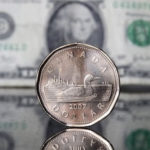The loonie, as the Canadian dollar is best known, declined against its US counterpart, following the comments of the Canadian Finance Minister, Jim Flaherty, who said the nations manufacturers may soon be helped by a weaker dollar.
Having hit a session high at 1.0681 at 14:07 GMT, USD/CAD traded at 1.0671 by 15:17 GMT, adding 0.24% for the day. Support was likely to be received at January 3rd low, 1.0602, while resistance was to be encountered at December 30th high, 1.0728.
“The governor was with us recently with the provincial ministers and he indicated there might be some softening in the dollar, but the dollar in the nineties somewhere is good for manufacturing,” Flaherty said in an interview yesterday, cited by Bloomberg. The comments of the Finance Minister came after Bank of Canada Governor Stephen Poloz briefed him and the provincial finance ministers at a meeting near Ottawa on December 16th.
The loonie was pressured after Statistics Canada reported today the countrys Raw Materials Price Index (RMPI) declined by 4.1% in November, after a 2.3% decrease in October. Analysts had expected that the index will decrease by mere 1.8% in November. The index can be viewed as a leading indicator, because it is a gauge of consumer inflation, which accounts for the largest portion of overall inflation.
A separate report by Statistics Canada revealed the nations Industrial Production Price Index (IPPI) rose by 0.1%, after it fell by 0.3% in October. Analysts had projected that the index will decline 0.2% in November.
Meanwhile, recent upbeat data spurred speculation that Fed might decide to taper its stimulus program further, supporting the greenback.
The Federal Reserve Bank said on December 18th that it plans to reduce its monthly bond purchases in January to $75 billion from $85 billion. According to the median estimate of economists surveyed by Bloomberg on December 19th, the Federal Reserve may reduce the purchases in $10 billion increments over the next seven meetings, before ending the program, which tends to devalue the US currency, in December 2014.
However, the greenback was pressured after a report by the Institute for Supply Management (ISM) revealed the activity in the US sector of services unexpectedly decreased in December. The corresponding Services PMI declined to a reading of 53.0 last month from 53.9 in November, short of analysts projections of an increase to 54.5.
The US Census Bureau released a report that showed the nations factory orders increased by 1.8% in November, after a decline of 0.9% in October, while analysts predicted the index to climb to 1.7%.
On Thursday the Department of Labor in the United States reported that the number of people, who filed for unemployment assistance during the week ended December 28th, dropped to 339 000 from the upwardly revised 341 000 in the preceding week. Analysts had projected that the number of initial jobless claims will increase to 342 000.
In addition, according to data by the Institute for Supply Management (ISM), US companies operating in the sector of manufacturing increased their activity at a weaker but still steady rate in December compared to November. The corresponding index, gauging the performance of manufacturing sector in the country, came in at a value of 57.0 in December, down from 57.3 in the previous month, which was also the highest level of the index in 2.5 years. Analysts had forecast that the manufacturing PMI will demonstrate a larger drop in December, to 56.9.
Elsewhere, having reached a session low at 1.6338 at 09:35 GMT, GBP/USD traded at 1.6378 at 12:16 GMT, losing 0.25% on a daily basis. Support was likely to be received at December 25th low, 1.6313, while resistance was to be encountered at January 3rd high, 1.6449. The pair settled last week 0.36% lower.





